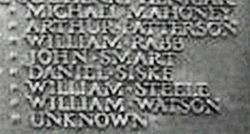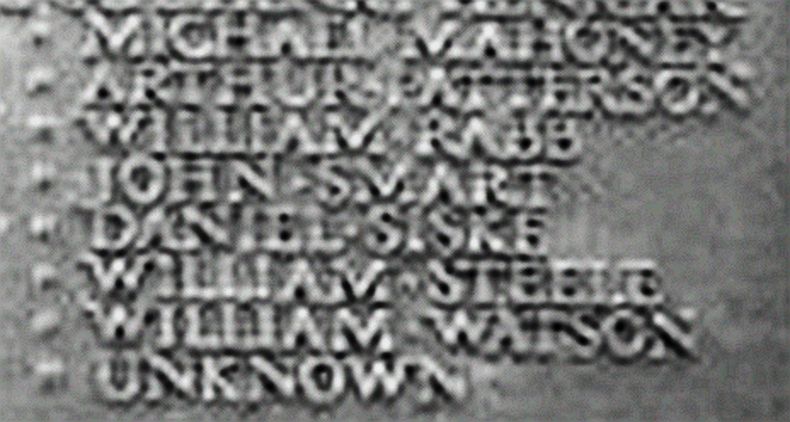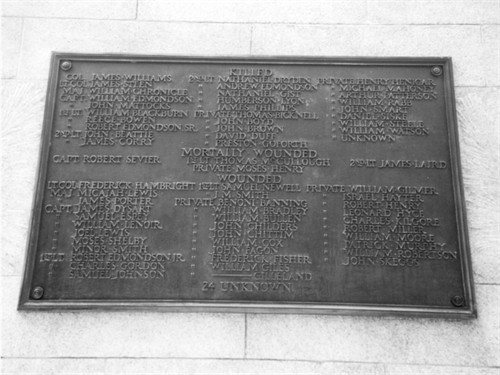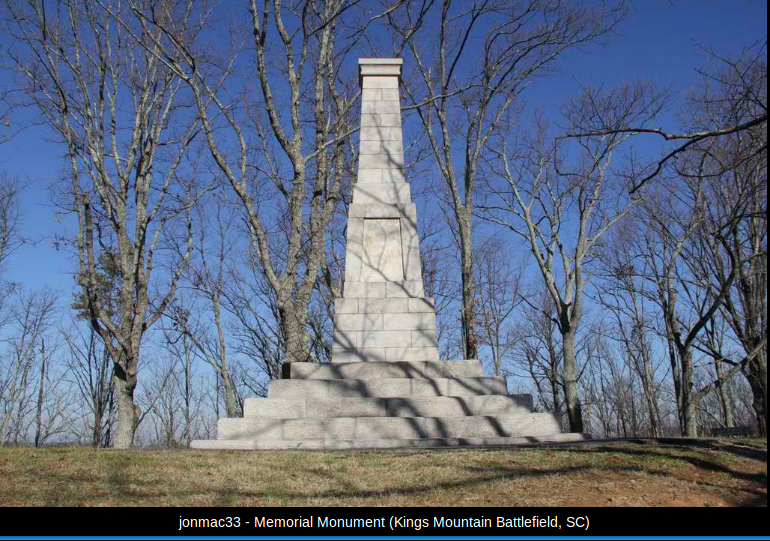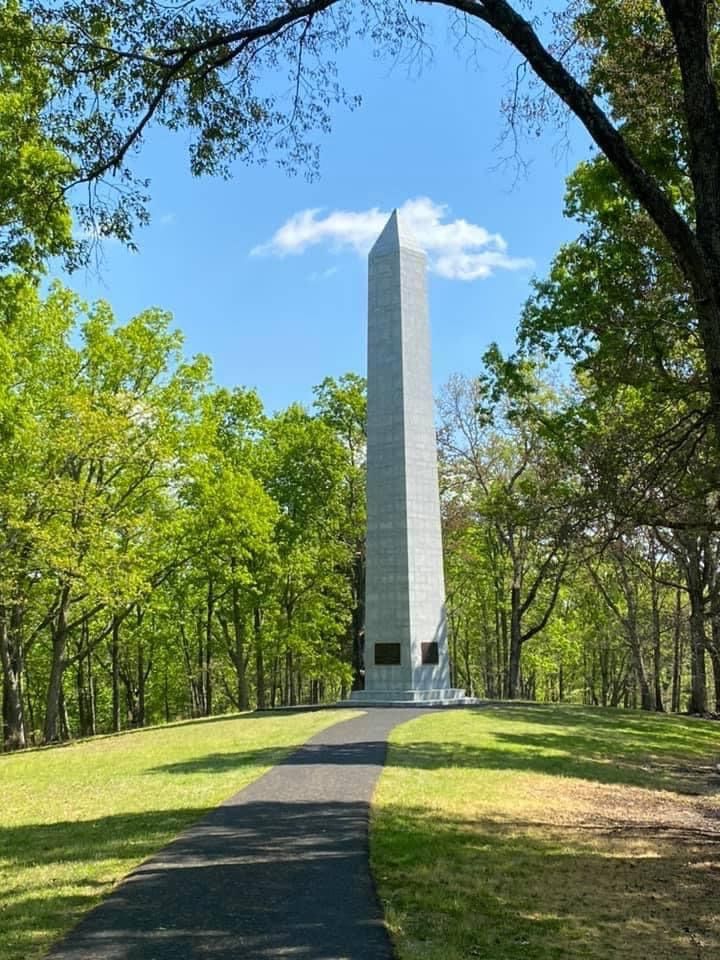Family Tree DNA
Daniel Sisk
1780, October 7--During the American Revolutionary War, a segment of Lord Cornwallis' forces led by Maj. Patrick Ferguson was defeated in the Battle of King's Mountain, in Cleveland County, North Carolina, by "mountain men" militia commanded by John Sevier, Isaac Shelby, William Campbell, and Benjamin Cleveland. Daniel Sisk of Wilkes County, North Carolina, was among the Americans killed in the battle. (See "Sisks in the American Revolution")
Daniel's sacrifice became a prideful honor for following generations of Sisks, and many families named sons Daniel, thus See Kentucky and Georgia Sisks.) Nellie Elizabeth Sisk was believed to have accompanied Gabriel Sisk to Georgia and was reported buried in the Amy's Creek Cemetery in Habersham County. No further trace of Emily Sisk, the fourth child, has been uncovered.
Prior to the adoption, Gabriel Loving has married Daniel Sisk's widow, Rachel, August 7, 1781, and they had children of their own. They moved to Virginia for a short time and later migrated to Kentucky where he and Rachel joined the Sisks in Hopkins County. (See Names Associated with the Sisks)
The Lovings and Sisks had been neighbors in Virginia before the migration to North Carolina. Daniel Sisk and Rachel Loving had married in Shenandoah County, Virginia, according to a 1772-1777 compilation of county marriages. This date bracket would indicated Daniel was born in the early 1750s and possibly was in his late 20's when he was killed. If those who served in the war were brothers, as legends have it, Daniel's father would have been Timothy* Sisk, the father of Bartlett Sisk*, a war veteran.
~~~~~~~~~~~~~~~~~~~~~~~~~
The BATTLE OF KING'S MOUNTAIN, OCTOBER 7, 1780
The Battle of King's Mountain, in which Daniel Sisk was killed, was one of the main turning points in the American Revolution, according to George C. McKenzie in the book, "King's Mountain National Park, South Carolina," published in 1955 by the National Park Service.
The book quotes Sir Henry Clifton, the British commander in chief in North America, as writing, "it was the first link in a chain of evils that followed...until they at last ended in the total loss of America."
The battle ground was along the crest of King's Mountain, actually an 18-mile range extending across the border between North and South Carolina, in what are now Cleveland County, North Carolina, and Cherokee County, South Carolina.
Another book, "King's Mountain and Its Heroes," gives a detailed account of the battle, events leading up to it and all available names of the participants and casualties on both sides. The Americans totaled 1000 from Eastern Tennessee, Virginia, and North and South Carolina. There were about 1100 in the British force, 100 regulars and 1000 Tories.
Among the American Revolutionary forces, Col. Benjamin Cleveland and Maj. Joseph Winston had brought 350 "mountain men" from Wilkes and Surry Counties, North Carolina. The Wilkes County men included Daniel Sisk and possibly other Sisks, several of whom lived in Wilkes and Surry Counties. This rag-tag group carried the burden of the assault up the side of the mountain and approached within a quarter mile of the enemy before being discovered when they opened fire. The battle started about 3 p.m. and lasted just about an hour. The entire British force was captured, wounded or killed, Mackenzie reports. There were 28 American killed and 62 wounded. Of the British, 157 were killed, 163 wounded and left on the field and 700 taken prisoner. Several Tories among those captured were hanged--not an unusual consequence after battles during the Revolution.
"Of the Wilkes and Surry men under Cleveland and Winston," the Heroes book recounts, "we have only the names of two men killed--Thomas Bicknell and Daniel Siske (sic) of Wilkes County; Major Lewis Captains Lewis, Smith, and Lenoir, Lieutenants Johnson and J.M. Smith, Charles Gordon, and John Childers wounded--the latter badly. Where so many officers were disabled, there must have been several others of this gallant regiment killed and wounded."
The British dead included the commander, Maj. Patrick Ferguson.
According to Mackenzie, the battle "halted the triumphant northward movement of Lord Cornwallis...in (his) final effort to end the Revolution. The engagement was a memorable example of the individual valor of the American frontier fighter, and the deadly effectiveness of his hunting rifle."
Cleveland's men from Wilkes and Surry were under heavy fire while hastening toward their point of assault, according to the Heroes book, which continued, "From the Colonel down to the humblest private they all heartily detested Tories, and fought them with a resolute determination to subdue them at all hazards. They sought all natural places of protection--trees, logs, rocks, and bushes...The men of Wilkes and Surry would dart from their places of concealment, and make a dash for more advanced positions...It was their persistency, their pluck, and excelling in the use of the rifle, that gave the mountaineers the victory."
Extracted from Luther L. Sisk's "SISK FAMILIES"
~~~~~~~~~~~~~~~~~~~~~~~~~~~~~~~~~~~~~~~~~~~~~~~~~~~~~~
Info taken from:
Some Early Pioneers of Western Kentucky their Ancestors and Descendants
By: Helen Elvoree Hart Peyton
The call to arms were heard through out the colonies, and Daniel Sisk joined the American Forces under Colonel Cleveland, whose regiment was made up of courageous volunteers from the countryside of the newly formed counties of Wilkes and Surry in North Carolina. Equipped with their trusty hunting rifle, a blanket, and a cup to hold their mixture of parched cornmeal and maple sugar, an occasional skillet may have been found among the patriots to warm their meal mixture, and perhaps to cook meat they happen to obtain on their trek to meet their enemy, the regiment set out on horseback for war...
Even two hundred and three years later, in 1983, as this complier walked the memorial circle on Kings Mountain, viewing the majestic monument, reading the name Daniel Siske (Sisk) among those that had fallen that 7 October of 1780, stopped by the grave site of the English Colonel Ferguson, who had been so young and handsome, and who fought so fervently, but lost his life there on the mountain that he had sworn to hold, saw the markers where many other heroes died that day long ago, listened to the recitation at strategic points of interest, it seemed to my mind's eye that I could hear the battle rage all round the mountain.
One of the tapes being played spoke of the mountain appearing volcanic. As the battle was in progress my mind's eye could see the flashing along the summit, and around the base of the mountain and up its side, one long sulfurous blaze. If one listened closely, the very air carried the shouts of the mountaineers, as well as the peals of hundreds of rifles and muskets. It seemed I could hear now and then, through the air waves, the voice of Colonel Cleveland shouting to his men, their enemy, as well as the enemy of mankind was yonder on the mountain.
Through the gently rustling leaves could be heard the faint but shrill screech of Ferguson's silver whistle high above the confusion of the battle, as well as the groans of the wounded and dying in every part of the memorial circle.
The Wilkes County regiment hated the Tories, and they were determined to subdue them at all cost. One would almost expect to see the mountain men dashing from tree to tree for protection, or lunge behind fallen logs, and hide behind bushes on the mountain side as Cleveland urged them on and up the mountain side. And when one did fall, his comrads became more determined to punish the Tories even more effectively.
Ferguson and his men were pinned on the summit of Kings Mountain. They neither had a chance of winning, nor of escaping. Ferguson is buried about where his horse fell, and where he died. A beautiful monument was erected in his honor. He was a young and most brilliant and able man, but badly misjudged the Tennessee and Wilkes County mountain men.
Daniel Sisk and Thomas Bicknell were the two men from Wilkes County, North Carolina that died that fateful day.
The Battle of Kings Mountain was the turning point in the Revolutionary War for the American Colonies.
As so little is known about the life of Daniel Sisk, his last actions in the life of the Wilkes County Regiment has been presented as heard on the memorial circle at Kings Mountain Park, and from the book, Kings Mountain and its Heroes, by Lyman C. Draper, L.L.D., 1881, reprinted by the Genealogical Publishing Company Inc. Baltimore, 1978.
On 27 August 1781, the widow of Daniel Sisk, Rachel (Lovin) Sisk and Gabriel Loving Jr. were issued a marriage license in Wilkes County, North Carolina. After their marriage, and in 1784, Gabriel Loving was appointed by the Wilkes County Court to be guardian of the orphan children of Daniel Sisk. On the 24th of July 1784, the Court recommended that fifteen pounds be applied by Gabriel Loving, the children's guardian. Children named by the Court were: Robert, Gabriel, Nellie and Emilie Sisk.
~~~~~~~~~~~~~~~~~~~~~~~~~~~~~~~~~~~~~~~~~~~~~~~~~~~~~~
Info from online:
Genealogy.com
Family Tree Maker
Ancestors of Stephanie Raymann
Daniel married Rachel Lovin on August 07, 1771
Children of Daniel Sisk and Rachel Lovin are:
Nellie Elizabeth (Betty) Sisk, d. date unknown.
Robert (Robin) Barney Sisk, b. December 20, 1775, ,Wilkes, NC, d. June 02, 1856, Madisonville, Hopkins, KY.
Gabriel Sisk, b. September 07, 1777, ,Wilkes, NC, d. September 26, 1859, Habersham, GA.
Emily Sisk, b. 1781, d. date unknown.
~~~~~~~~~~~~~~~~~~~~~~~~~~~~~~~~~~~~~~~~~~~~~~~~~~~~~~
Info from online:
National Park Service
Kings Mountain
National Military Park
South Carolina
The battle of Kings Mountain lasted about one hour. Americans lost 28, Loyalists lost 225 and 716 were captured.
The dead were buried on the battlefield in unmarked graves, they have never been found.
~~~~~~~~~~~~~~~~~
From this information I am assuming he is buried on Kings Mountain but I also read that some time after the battle the bodies were removed and put in common unmarked graves...some where. If Daniel Sisk is not buried on Kings Mountain, this is still a memorial in honor of him, where ever he may be.
Doing a "search" on Find-A-Grave of all the Daniel Sisks in the U.S.A. there were eleven (11) listed and none of them this Daniel Sisk. I have a screen shot photo of that listing. If any one can show me his Memorial they created before todays date on which I created this one, I will delete this memorial. If any one can provide documented proof he is buried else where, I will delete this memorial and they may create a memorial for him in that resting place.
Family Tree DNA
Daniel Sisk
1780, October 7--During the American Revolutionary War, a segment of Lord Cornwallis' forces led by Maj. Patrick Ferguson was defeated in the Battle of King's Mountain, in Cleveland County, North Carolina, by "mountain men" militia commanded by John Sevier, Isaac Shelby, William Campbell, and Benjamin Cleveland. Daniel Sisk of Wilkes County, North Carolina, was among the Americans killed in the battle. (See "Sisks in the American Revolution")
Daniel's sacrifice became a prideful honor for following generations of Sisks, and many families named sons Daniel, thus See Kentucky and Georgia Sisks.) Nellie Elizabeth Sisk was believed to have accompanied Gabriel Sisk to Georgia and was reported buried in the Amy's Creek Cemetery in Habersham County. No further trace of Emily Sisk, the fourth child, has been uncovered.
Prior to the adoption, Gabriel Loving has married Daniel Sisk's widow, Rachel, August 7, 1781, and they had children of their own. They moved to Virginia for a short time and later migrated to Kentucky where he and Rachel joined the Sisks in Hopkins County. (See Names Associated with the Sisks)
The Lovings and Sisks had been neighbors in Virginia before the migration to North Carolina. Daniel Sisk and Rachel Loving had married in Shenandoah County, Virginia, according to a 1772-1777 compilation of county marriages. This date bracket would indicated Daniel was born in the early 1750s and possibly was in his late 20's when he was killed. If those who served in the war were brothers, as legends have it, Daniel's father would have been Timothy* Sisk, the father of Bartlett Sisk*, a war veteran.
~~~~~~~~~~~~~~~~~~~~~~~~~
The BATTLE OF KING'S MOUNTAIN, OCTOBER 7, 1780
The Battle of King's Mountain, in which Daniel Sisk was killed, was one of the main turning points in the American Revolution, according to George C. McKenzie in the book, "King's Mountain National Park, South Carolina," published in 1955 by the National Park Service.
The book quotes Sir Henry Clifton, the British commander in chief in North America, as writing, "it was the first link in a chain of evils that followed...until they at last ended in the total loss of America."
The battle ground was along the crest of King's Mountain, actually an 18-mile range extending across the border between North and South Carolina, in what are now Cleveland County, North Carolina, and Cherokee County, South Carolina.
Another book, "King's Mountain and Its Heroes," gives a detailed account of the battle, events leading up to it and all available names of the participants and casualties on both sides. The Americans totaled 1000 from Eastern Tennessee, Virginia, and North and South Carolina. There were about 1100 in the British force, 100 regulars and 1000 Tories.
Among the American Revolutionary forces, Col. Benjamin Cleveland and Maj. Joseph Winston had brought 350 "mountain men" from Wilkes and Surry Counties, North Carolina. The Wilkes County men included Daniel Sisk and possibly other Sisks, several of whom lived in Wilkes and Surry Counties. This rag-tag group carried the burden of the assault up the side of the mountain and approached within a quarter mile of the enemy before being discovered when they opened fire. The battle started about 3 p.m. and lasted just about an hour. The entire British force was captured, wounded or killed, Mackenzie reports. There were 28 American killed and 62 wounded. Of the British, 157 were killed, 163 wounded and left on the field and 700 taken prisoner. Several Tories among those captured were hanged--not an unusual consequence after battles during the Revolution.
"Of the Wilkes and Surry men under Cleveland and Winston," the Heroes book recounts, "we have only the names of two men killed--Thomas Bicknell and Daniel Siske (sic) of Wilkes County; Major Lewis Captains Lewis, Smith, and Lenoir, Lieutenants Johnson and J.M. Smith, Charles Gordon, and John Childers wounded--the latter badly. Where so many officers were disabled, there must have been several others of this gallant regiment killed and wounded."
The British dead included the commander, Maj. Patrick Ferguson.
According to Mackenzie, the battle "halted the triumphant northward movement of Lord Cornwallis...in (his) final effort to end the Revolution. The engagement was a memorable example of the individual valor of the American frontier fighter, and the deadly effectiveness of his hunting rifle."
Cleveland's men from Wilkes and Surry were under heavy fire while hastening toward their point of assault, according to the Heroes book, which continued, "From the Colonel down to the humblest private they all heartily detested Tories, and fought them with a resolute determination to subdue them at all hazards. They sought all natural places of protection--trees, logs, rocks, and bushes...The men of Wilkes and Surry would dart from their places of concealment, and make a dash for more advanced positions...It was their persistency, their pluck, and excelling in the use of the rifle, that gave the mountaineers the victory."
Extracted from Luther L. Sisk's "SISK FAMILIES"
~~~~~~~~~~~~~~~~~~~~~~~~~~~~~~~~~~~~~~~~~~~~~~~~~~~~~~
Info taken from:
Some Early Pioneers of Western Kentucky their Ancestors and Descendants
By: Helen Elvoree Hart Peyton
The call to arms were heard through out the colonies, and Daniel Sisk joined the American Forces under Colonel Cleveland, whose regiment was made up of courageous volunteers from the countryside of the newly formed counties of Wilkes and Surry in North Carolina. Equipped with their trusty hunting rifle, a blanket, and a cup to hold their mixture of parched cornmeal and maple sugar, an occasional skillet may have been found among the patriots to warm their meal mixture, and perhaps to cook meat they happen to obtain on their trek to meet their enemy, the regiment set out on horseback for war...
Even two hundred and three years later, in 1983, as this complier walked the memorial circle on Kings Mountain, viewing the majestic monument, reading the name Daniel Siske (Sisk) among those that had fallen that 7 October of 1780, stopped by the grave site of the English Colonel Ferguson, who had been so young and handsome, and who fought so fervently, but lost his life there on the mountain that he had sworn to hold, saw the markers where many other heroes died that day long ago, listened to the recitation at strategic points of interest, it seemed to my mind's eye that I could hear the battle rage all round the mountain.
One of the tapes being played spoke of the mountain appearing volcanic. As the battle was in progress my mind's eye could see the flashing along the summit, and around the base of the mountain and up its side, one long sulfurous blaze. If one listened closely, the very air carried the shouts of the mountaineers, as well as the peals of hundreds of rifles and muskets. It seemed I could hear now and then, through the air waves, the voice of Colonel Cleveland shouting to his men, their enemy, as well as the enemy of mankind was yonder on the mountain.
Through the gently rustling leaves could be heard the faint but shrill screech of Ferguson's silver whistle high above the confusion of the battle, as well as the groans of the wounded and dying in every part of the memorial circle.
The Wilkes County regiment hated the Tories, and they were determined to subdue them at all cost. One would almost expect to see the mountain men dashing from tree to tree for protection, or lunge behind fallen logs, and hide behind bushes on the mountain side as Cleveland urged them on and up the mountain side. And when one did fall, his comrads became more determined to punish the Tories even more effectively.
Ferguson and his men were pinned on the summit of Kings Mountain. They neither had a chance of winning, nor of escaping. Ferguson is buried about where his horse fell, and where he died. A beautiful monument was erected in his honor. He was a young and most brilliant and able man, but badly misjudged the Tennessee and Wilkes County mountain men.
Daniel Sisk and Thomas Bicknell were the two men from Wilkes County, North Carolina that died that fateful day.
The Battle of Kings Mountain was the turning point in the Revolutionary War for the American Colonies.
As so little is known about the life of Daniel Sisk, his last actions in the life of the Wilkes County Regiment has been presented as heard on the memorial circle at Kings Mountain Park, and from the book, Kings Mountain and its Heroes, by Lyman C. Draper, L.L.D., 1881, reprinted by the Genealogical Publishing Company Inc. Baltimore, 1978.
On 27 August 1781, the widow of Daniel Sisk, Rachel (Lovin) Sisk and Gabriel Loving Jr. were issued a marriage license in Wilkes County, North Carolina. After their marriage, and in 1784, Gabriel Loving was appointed by the Wilkes County Court to be guardian of the orphan children of Daniel Sisk. On the 24th of July 1784, the Court recommended that fifteen pounds be applied by Gabriel Loving, the children's guardian. Children named by the Court were: Robert, Gabriel, Nellie and Emilie Sisk.
~~~~~~~~~~~~~~~~~~~~~~~~~~~~~~~~~~~~~~~~~~~~~~~~~~~~~~
Info from online:
Genealogy.com
Family Tree Maker
Ancestors of Stephanie Raymann
Daniel married Rachel Lovin on August 07, 1771
Children of Daniel Sisk and Rachel Lovin are:
Nellie Elizabeth (Betty) Sisk, d. date unknown.
Robert (Robin) Barney Sisk, b. December 20, 1775, ,Wilkes, NC, d. June 02, 1856, Madisonville, Hopkins, KY.
Gabriel Sisk, b. September 07, 1777, ,Wilkes, NC, d. September 26, 1859, Habersham, GA.
Emily Sisk, b. 1781, d. date unknown.
~~~~~~~~~~~~~~~~~~~~~~~~~~~~~~~~~~~~~~~~~~~~~~~~~~~~~~
Info from online:
National Park Service
Kings Mountain
National Military Park
South Carolina
The battle of Kings Mountain lasted about one hour. Americans lost 28, Loyalists lost 225 and 716 were captured.
The dead were buried on the battlefield in unmarked graves, they have never been found.
~~~~~~~~~~~~~~~~~
From this information I am assuming he is buried on Kings Mountain but I also read that some time after the battle the bodies were removed and put in common unmarked graves...some where. If Daniel Sisk is not buried on Kings Mountain, this is still a memorial in honor of him, where ever he may be.
Doing a "search" on Find-A-Grave of all the Daniel Sisks in the U.S.A. there were eleven (11) listed and none of them this Daniel Sisk. I have a screen shot photo of that listing. If any one can show me his Memorial they created before todays date on which I created this one, I will delete this memorial. If any one can provide documented proof he is buried else where, I will delete this memorial and they may create a memorial for him in that resting place.
Family Members
Advertisement
Explore more
Sponsored by Ancestry
Advertisement
